Are you tired of sweating through the summer months? A mini-split air conditioner could be the answer to your prayers. But with so many options on the market, how do you know which one to choose? Don’t worry, we’ve got you covered.
Mini-split air conditioners are a great alternative to traditional central air systems, especially for those who don’t have ductwork in their homes. In this buying guide, we’ll walk you through everything you need to know about mini-split air conditioners, from the benefits and features to consider to installation and maintenance tips. By the end of this guide, you’ll be ready to make an informed decision and enjoy cool, comfortable air all summer long.
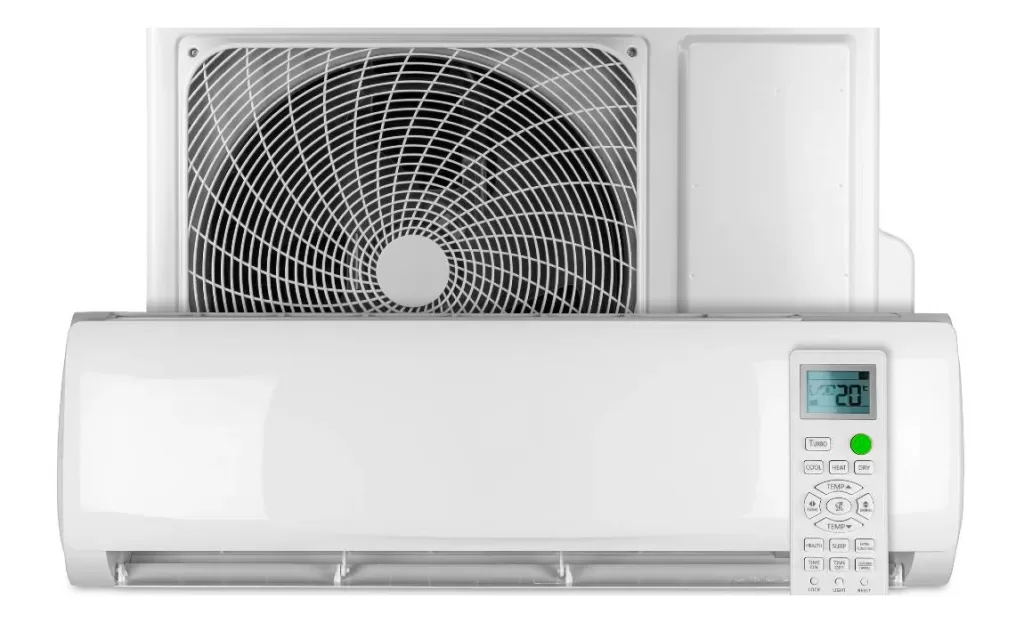
What is a Mini-Split Air Conditioner?
Benefits of Mini-Split Systems
Considerations for Buying a Mini-Split System
Heating Mode Options for Efficiency
Portable vs. Ductless Mini-Splits
Installation Requirements and Professional Help
DIY Installations for Window Units or Portable Systems
Refrigerant Lines, Outdoor Unit, and Indoor Unit Placement in Ductless Systems
What is a Mini-Split Air Conditioner?
Mini-split air conditioners, also known as ductless mini – split systems are compact and efficient cooling solutions ideal for residential and commercial spaces. These systems consist of two main components – indoor and outdoor units. The indoor unit is responsible for air circulation and cooling, while the outdoor unit houses the compressor.
Advantages
One of the most significant advantages of mini-split air conditioners is their energy efficiency. Unlike central air conditioning systems, mini – splits do not require ductwork, reducing energy loss and lowering energy consumption.
Furthermore, mini-splits have a high seasonal energy efficiency ratio (SEER) rating ensuring energy savings and lower utility bills.
Key Advantages
Another critical advantage of mini – splits air conditioners is their flexibility. With multi-zone systems, it is possible to have multiple indoor units connected to a single outdoor compressor, allowing for personalized cooling in different areas of the building. Additionally, mini-splits offer convenient features such as quiet operation and adjustable fan speed settings for enhanced comfort.
Mini-split air conditioners are popular for those looking to cool specific areas of their homes or offices. Their compact size and easy installation also make them suitable for smaller spaces or buildings where traditional systems may not be feasible. Whether you need to cool a single room or multiple zones, mini split ac provide efficient and customizable cooling solutions.
You may also be interested in: 9 Common Air Conditioning Problems You Should Know About
Benefits of Mini-Split Systems
Mini-split air conditioning unit offer many benefits that make them an excellent choice for cooling your space. These systems are gaining popularity for their efficiency, flexibility, and convenient features.
One of the most significant advantages of mini-split systems is their energy efficiency. Unlike traditional air conditioning units; mini-splits do not rely on ductwork to distribute cool air throughout the building. This means there is no energy loss associated with ducts, leading to lower energy consumption and more cost-effective operation. By eliminating ductwork, mini-splits are also less prone to air leaks, ensuring that the cooled air reaches its intended destination without any wastage.
In addition to energy efficiency, mini-split systems have a high seasonal energy efficiency ratio (SEER) rating. This rating indicates the cooling output compared to the energy input, and the higher the SEER rating, the more energy efficient the system is. With SEER ratings typically ranging from 13 to 30, mini-splits offer significant energy savings and can help reduce your utility bills.
Flexibility
Another benefit of mini-split systems is their flexibility. With the ability to have multiple indoor units connected to a single outdoor compressor, these systems provide personalized cooling in different areas of the building. This is particularly useful for larger spaces or buildings with multiple rooms where maintaining a consistent temperature throughout can be challenging. Each indoor unit can be independently controlled, allowing you to customize the cooling settings according to your preferences and requirements. This zoning capability not only enhances comfort but also ensures energy efficiency by cooling only the areas that are in use.
Exceptional Features
Mini-split systems also come with convenient features that enhance comfort and usability. These include quiet operation, adjustable fan speed settings and programmable timers. The quiet operation ensures that you can enjoy a peaceful environment without any distracting noise from the air conditioner. With adjustable fan speed settings, you can customize the airflow to suit your comfort level. Additionally, programmable timers allow you to set the system to turn on or off at specific times, allowing you to optimize energy usage according to your schedule.
Installation of Mini-Split Unit
Installing a mini-split system is also relatively easy and does not require extensive renovations. The indoor units can be mounted on the walls or ceiling, providing flexibility in terms of placement. Moreover, mini-split systems do not require a large outdoor unit, making them suitable for spaces with limited outdoor areas or stringent aesthetic requirements.
With all these benefits, it is no wonder that mini-split systems are becoming increasingly popular for cooling needs. Their energy efficiency, flexibility, and convenient features make them a smart choice for residential and commercial applications. So, if you want an efficient, customizable, and user-friendly cooling solution, consider investing in a mini-split air conditioning system. You’ll enjoy enhanced comfort, save energy, and reduce your utility bills in the long run.
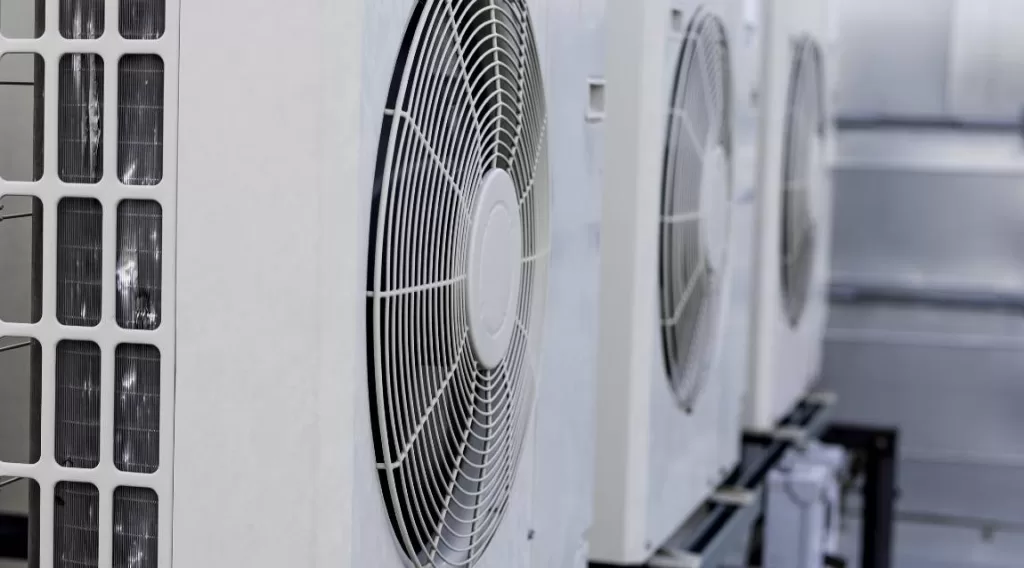
Considerations for Buying a Mini-Split System
When it comes to buying a mini-split system, there are several key considerations to keep in mind. These considerations will help you make an informed decision and ensure you choose the right system for your specific needs and requirements.
Consider Size and Capacity
First and foremost, determining the size and capacity of the mini-split system is crucial. This is typically measured in British Thermal Units (BTUs) and is determined by the size of the space you want to cool. It’s essential to accurately calculate the square footage of the area and choose a system with the appropriate BTU rating. Going for a system that is too small will result in insufficient cooling while choosing a system that is too large will lead to unnecessary energy consumption and higher costs.
Efficiency
Energy efficiency is another vital factor to consider. Look for a mini-split system with a high Seasonal Energy Efficiency Ratio (SEER) rating. The SEER rating indicates the cooling output compared to the energy input, and the higher the rating, the more energy efficient the system is. Opting for a system with a higher SEER rating can result in significant energy savings and lower utility bills over time.
Single Zone or Multi-Zone
Next, consider whether you need a single-zone or multi-zone system. A single-zone system consists of one indoor unit connected to an outdoor compressor, providing cooling for a specific area or room. On the other hand, a multi-zone system allows for multiple indoor units to be connected to a single outdoor compressor, providing cooling for different areas or rooms. If you have a larger space or multiple rooms requiring independent temperature control, a multi-zone system may be the better option.
Installation is another important consideration. While mini-split systems are generally easier to install compared to traditional systems, it’s still recommended to hire a professional for the installation process. They will ensure that the system is correctly installed and properly connected, maximizing its efficiency and performance. Additionally, professionals have the expertise to properly size and position indoor units for optimal airflow and cooling.
Specific Requirements
Lastly, consider your specific needs and preferences regarding additional features and functionality. Mini-split systems have various convenient features, such as remote control operation, programmable timers, adjustable fan speeds, and even Wi-Fi connectivity for smart home integration. Consider what features are important to you and choose a system that offers functionalities that align with your lifestyle and requirements.
By carefully considering these factors, you can confidently choose the right mini-split system. Whether for a small room or a larger space, energy efficiency, customization and ease of installation are key factors to ensure optimal comfort and cost-effective operation. So, research and compare different models and consult with professionals to make an informed decision that suits your specific needs and preferences.
Size and Capacity
Determining the size and capacity of your mini-split AC is a crucial step in ensuring optimal cooling performance and energy efficiency. The size and capacity of a mini-split system are typically measured in British Thermal Units (BTUs). This measurement is directly related to the cooling power of the unit, and choosing the right BTU rating for your space is vital.
Determine Required BTU Rating
To accurately determine the required BTU rating; start by calculating the square footage of the area you want to cool. Measure the length and width of the room, and multiply these two numbers together. For example, if your room measures 10 feet by 12 feet, the square footage would be 120 square feet. The BTU rating needed for a space depends on various factors, such as insulation, ceiling height, and the number of windows.
It’s important to note that choosing a system with a BTU rating that is too small will result in inadequate cooling, leaving you feeling hot and uncomfortable. On the other hand, selecting a system with a BTU rating that is too large will lead to unnecessary energy consumption and higher costs. Oversized units tend to cycle on and off frequently, reducing energy efficiency and causing temperature fluctuations in the room.
To ensure an accurate BTU rating, consider consulting with a professional HVAC technician. They have the expertise to assess your space properly and recommend the appropriate BTU rating for your mini-split system.
Additional Factors
Keep in mind that other factors also affect the size and capacity of your mini-split air conditioner. For instance, if your room receives a significant amount of direct sunlight or has multiple heat-generating appliances, you may need a system with a higher BTU rating to compensate for the additional heat load.
In conclusion, determining the size and capacity of your mini-split air conditioner is essential for efficient and effective cooling. Accurately calculating the required BTU rating based on the square footage and considering other factors specific to your space will ensure optimal performance and energy savings. Consulting with a professional HVAC technician can provide invaluable guidance throughout the process.

Calculating Square Footage
Calculating the square footage of a room or space is a fundamental step in determining the right size mini-split air conditioner for your needs. Whether you’re looking to cool a bedroom, a living room, or even a commercial space, accurately measuring the square footage is crucial to ensure optimal cooling efficiency.
To get started, you’ll need a measuring tape and a pen and paper to record your measurements.
- Begin by measuring the length and width of the room, taking note of any irregularities or angles that may affect the overall shape. For example, if your room is rectangular with straight walls, measure the length and width in feet.
- Once you have the measurements, multiply the length and width together. For instance, if your room measures 12 feet in length and 10 feet in width, multiplying these two numbers would give you a total of 120 square feet. This is the basic equation for determining the square footage of a rectangular or square-shaped room.
Additional Sections or Alcoves
If your room has any additional sections or alcoves, you’ll need to calculate their square footage separately and then add it to the main area. This can be done by breaking down the room into smaller, more manageable shapes.
For example, if you have a dining nook that protrudes from the main room, measure its length and width and multiply them together to obtain the square footage. Repeat this process for any additional areas and then add them to the total square footage of the main room.
Irregular Shapes or Non-rectangular Dimensions
It’s important to note that if your room has irregular shapes or non-rectangular dimensions, calculating the square footage can become a bit more complex. In such cases, you may need to divide the room into smaller, more regularly-shaped sections and calculate their square footage individually. Afterwards, you can sum up all the individual square footages to get the total square footage of the room.
Calculating the square footage is a necessary step in determining the appropriate BTU rating for your mini-split air conditioner. By accurately measuring the dimensions of your space, you can ensure that your cooling needs are met efficiently and effectively.
Remember, when in doubt, it’s always best to consult a professional HVAC technician who can provide expert guidance and recommendations for your situation.
BTU Rating of Equipment
When it comes to choosing the right mini-split air conditioner, one of the key factors to consider is the BTU rating of the equipment.
The BTU rating of an air conditioner is directly related to the size and cooling capacity of the unit. It represents the amount of heat energy the air conditioner can remove from a room in one hour. The general rule of thumb is that the higher the BTU rating, the larger the space the air conditioner can effectively cool.
To determine the appropriate BTU rating for your mini-split air conditioner, you need to consider the square footage of the area you want to cool. As mentioned earlier, measuring the square footage involves multiplying the length and width of the room. Once you have this measurement, you can use it as a guide to select the right BTU rating for your mini-split air conditioner.
High BTU Rating
It’s important to note that selecting an air conditioner with a BTU rating that is too high for your room can result in inefficient cooling and increased energy consumption.
Low BTU Rating
On the other hand, if the BTU rating is too low, the air conditioner may struggle to cool the room adequately.
Room Size
To give you a rough estimate, here’s a general guideline for selecting the appropriate BTU rating based on room size:
- 150 to 350 square feet: 5,000 to 8,000 BTU
- 350 to 550 square feet: 8,000 to 12,000 BTU
- 550 to 1,050 square feet: 12,000 to 18,000 BTU
- 1,050 to 1,650 square feet: 18,000 to 24,000 BTU
Keep in mind that these are approximate values and other factors, such as the climate, insulation, and the number of people occupying the room, can also affect the cooling requirements. So, it’s always a good idea to consult with a professional or refer to the manufacturer’s guidelines to determine the most suitable BTU rating for your specific needs.
In conclusion, understanding the BTU rating of mini-split air conditioning equipment is crucial for selecting the right cooling capacity for your space. By considering the square footage of the area and using the general guidelines provided, you can make an informed decision and ensure optimal cooling comfort in your home or office.
SEER Ratings of the Unit
When it comes to purchasing a mini-split air conditioner, one important factor to consider is the SEER rating of the unit. SEER, which stands for Seasonal Energy Efficiency Ratio, is a measure of how efficiently the air conditioner can cool your space.
In simple terms, the SEER rating tells you how many BTUs (British Thermal Unit) of cooling capacity the air conditioner can provide for each watt of electricity it consumes. The higher the SEER rating, the more energy efficient the unit is.
Why is this Important?
Well, an air conditioner with a higher SEER rating can provide the same level of cooling as a unit with a lower SEER rating, but will do so using less energy. This means that you can enjoy a comfortable indoor environment while keeping your energy bills in check.
In the United States, the minimum SEER rating for new air conditioners is 14. However, there are units available in the market with even higher SEER ratings, ranging from 16 to 25. These high SEER rated units not only provide superior energy efficiency, but they can also help you qualify for energy-saving rebates or incentives offered by utility companies or government programs.
When considering SEER ratings, it’s important to remember that while higher SEER-rated units may have a higher upfront cost, but they can lead to significant long-term savings on your energy bills. Additionally, selecting a unit with a higher SEER rating also contributes to a greener and more sustainable environment by reducing your carbon footprint.
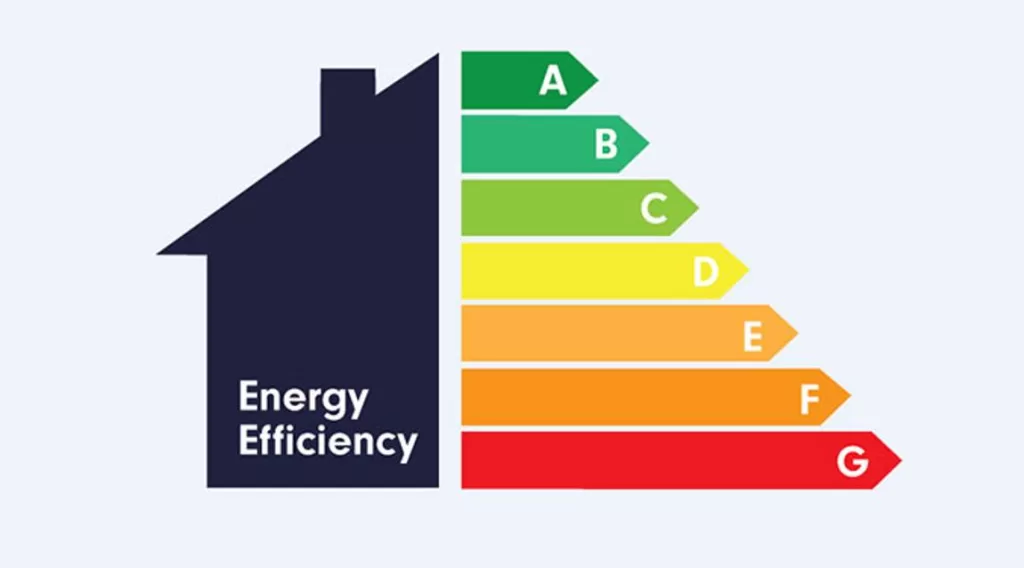
Evaluating Energy Efficiency
It’s worth noting that the SEER rating is just one aspect to consider when evaluating the energy efficiency of a mini-split air conditioner. Other factors, such as the inverter compressor technology, which allows the unit to adjust its cooling capacity according to demand, and your space’s overall design and insulation also play a role in determining energy efficiency.
To ensure that you choose the right mini-split air conditioner with the optimal SEER rating for your needs, it is recommended to consult with a professional HVAC technician who can assess your specific requirements and provide personalized recommendations.
In summary, when shopping for a mini-split air conditioner, pay attention to the SEER rating of the unit. A higher SEER rating translates to greater energy efficiency, which means lower energy bills and a smaller environmental impact. So, choose wisely and enjoy a cool and comfortable indoor environment while keeping your energy usage in check.
Efficiency and Cost Savings
When it comes to keeping our homes cool during the hot summer months, energy efficiency and cost savings are two factors that we all consider. Nobody wants to receive a jaw-dropping energy bill just for trying to stay comfortable indoors. That’s why it’s important to understand how efficiency and cost savings go hand in hand when it comes to mini-split air conditioners.
Efficiency is all about getting the most cooling power out of every watt of electricity consumed. And that’s where SEER ratings come into play. SEER stands for Seasonal Energy Efficiency Ratio and it tells you just how efficient an air conditioner is. The higher the SEER rating, the more efficiently it operates.
Why Should You Care About Efficiency?
Well, apart from being kinder to the environment, an air conditioner with a higher SEER rating can save you a significant amount of money in the long run. It may require a higher initial investment, but the energy savings over time can outweigh the upfront cost. In fact, a unit with a high SEER rating can reduce your energy bills by up to 30% compared to a unit with a lower SEER rating.
But energy efficiency is not the only factor to consider when it comes to cost savings. The overall design and insulation of your space, as well as the inverter compressor technology, also play significant roles. Inverter compressors can adjust the cooling capacity of the unit according to demand, meaning it can ramp up or down its energy consumption based on the temperature needs of your room. This prevents wasteful energy usage and ensures that your mini-split air conditioner only uses the energy it actually needs.
Why Invest in an Energy-efficient Mini-Split AC System?
To put it simply, investing in an energy-efficient mini-split air conditioner can help you stay cool while keeping your energy bills under control. But finding the right unit with the optimal SEER rating for your specific needs can be a bit overwhelming. That’s why it’s always recommended to consult with a professional HVAC technician. They can assess your space, consider factors like square footage and insulation, and provide you with personalized recommendations on the most efficient and cost-effective mini-split air conditioner for your home.
So, if you’re looking to beat the heat without breaking the bank, consider investing in an energy-efficient mini-split air conditioner. It’s a decision that not only saves you money, but also contributes to a more sustainable and eco-friendly future.
Energy Star Rated Systems
When it comes to choosing an energy-efficient mini-split air conditioner, there’s one important label you should look for: Energy Star. The Energy Star rating is awarded to products that meet strict guidelines set by the U.S. Environmental Protection Agency and the Department of Energy. These guidelines ensure that the products are not only energy-efficient but also perform at a high level.
Why Should You Opt for an Energy Star-Rated Mini-Split System?
Well, for starters, these systems have been proven to reduce energy usage and save you money on your utility bills. They are designed with advanced technology that maximizes cooling power while minimizing energy consumption. By investing in an Energy Star-rated mini-split air conditioner; you’ll be doing your part in conserving energy and reducing your carbon footprint.
But that’s not all. Energy Star-rated mini-split air conditioners also come with additional benefits. They often feature convenient features like programmable thermostats, which allow you to customize temperature settings according to your schedule. This not only adds to your comfort but also further optimizes energy usage by cooling your space only when necessary.
Performance and Durability
Furthermore, Energy Star-rated mini-split systems undergo rigorous testing to ensure their performance and durability. This means you can trust that you’re investing in a reliable and long-lasting product that will provide you with efficient cooling for years to come.
Rebates
Another advantage is that Energy Star-rated mini-split air conditioners may qualify for rebates or incentives offered by utility companies or government agencies. These incentives can further offset the initial cost of the unit, making it even more cost-effective in the long run.
EER and SEER Ratings
When shopping for an Energy Star-rated mini-split air conditioner; pay attention to the energy efficiency ratio (EER) and SEER ratings. The EER measures how efficiently the unit operate at a specific temperature, while the SEER indicates its overall seasonal energy efficiency. Look for higher numbers in both ratings to ensure maximum energy savings.
In conclusion, choosing an Energy Star-rated mini-split air conditioner is a smart investment for both your wallet and the environment. Not only will you enjoy significant energy savings, but you’ll also benefit from the latest technology, convenient features, and potential rebate opportunities. So, make the eco-friendly choice and opt for an Energy Star-rated system that will keep you cool while keeping your energy costs in check.
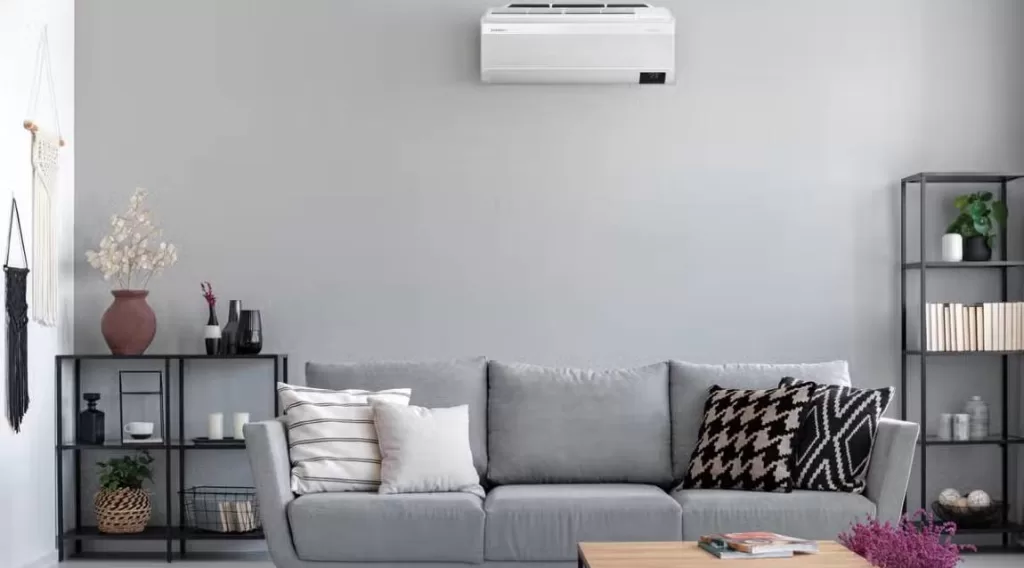
Heating Mode Options for Efficiency
Looking to maximize efficiency and comfort during the colder months? Look no further than mini-split air conditioners with heating mode options. These innovative systems offer a convenient and energy-efficient solution for heating your space, eliminating the need for separate heating systems and reducing energy costs.
Key Advantages
One of the key advantages of mini-split air conditioners with heating mode is their ability to provide both cooling and heating functions in a single unit. This eliminates the need for multiple appliances and the associated energy consumption. With a simple click of a button, you can seamlessly switch between cooling and heating modes, ensuring your space stays comfortable no matter the season.
How do These Systems Achieve Such Efficient Heating?
It all comes down to the inverter compressor technology found in many mini-split air conditioners. Unlike traditional systems that work in an on/off fashion; inverter compressors adjust their speed according to the heating requirements, providing a more precise and energy-efficient heating experience. This not only ensures consistent temperature control but also prevents energy wastage by avoiding frequent cycling on and off.
Heat Mode
Mini-split ACs with heating mode offer zoned heating capabilities. This means you can independently control the temperature in different areas or rooms, allowing for personalized comfort and energy savings. By only heating the rooms that are in use, you can effectively reduce energy consumption and lower your utility bills.
Heating Seasonal Performance Factor (HSPF)
When it comes to efficiency ratings, keep an eye out for the Heating Seasonal Performance Factor (HSPF). This rating measures the efficiency of the heating mode in mini-split air conditioners. Look for models with higher HSPF ratings as they indicate better energy performance and lower operating costs.
Multi-System Zone
Another feature to consider is the option for a multi-zone system. This allows you to connect multiple indoor units to a single outdoor compressor, providing heating to different rooms or areas simultaneously. With this setup, you have the flexibility to customize the heating requirements of each zone, optimizing comfort and energy savings.
Professional Installation
Professional installation is crucial for maximizing the efficiency of your mini-split air conditioner’s heating mode. Improper installation can result in energy loss, reduced performance, and potential safety hazards. Make sure to hire a qualified HVAC technician who is experienced in installing mini-split systems to ensure proper function and optimal energy efficiency.
In conclusion, mini-split air conditioners with heating mode provide efficient and customizable heating solutions for any space. With their inverter compressor technology, zoned heating capabilities and high HSPF ratings; these systems offer both comfort and energy savings. Invest in a mini-split air conditioner with heating mode and enjoy the benefits of efficient heating during the colder months.
Inverter Compressor Technology
Inverter Compressor Technology: The Secret to Efficient Heating in Mini-Split Air Conditioners
When it comes to heating your space during the chilly winter months, mini-split air conditioners with heating mode offer a convenient and energy-efficient solution. These systems not only provide effective cooling in the summer but also ensure cozy warmth in the winter, all in one sleek and compact unit.
Have You Ever Wondered How They Achieve Efficient Heating?
The answer lies in the innovative inverter compressor technology.
Unlike traditional air conditioning systems that operates in an on/off fashion, mini-split air conditioners with inverter compressor technology work differently. These intelligent compressors constantly adjust their speed based on the heating requirements, which results in precise and efficient heating. This means no more uncomfortable temperature fluctuations or energy wastage due to frequent cycling on and off.
The beauty of inverter compressor technology lies in its ability to provide consistent and comfortable heating while minimizing energy consumption. The inverter compressor’s adaptive speed control ensures that your space maintains the desired temperature without consuming unnecessary energy. This translates to lower heating costs and reduced carbon footprint, making it an eco-friendly choice for your home or office.
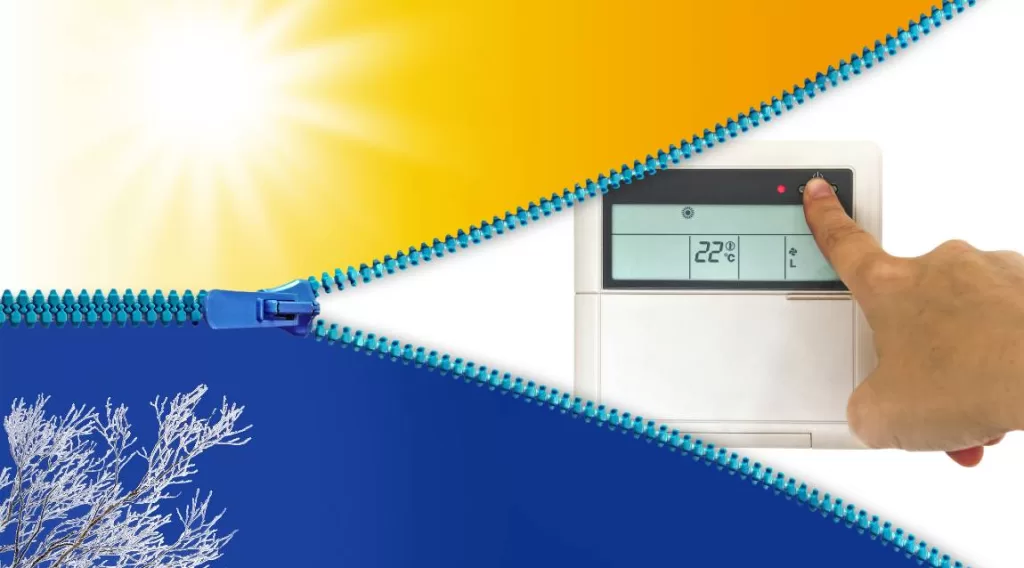
Control Temperature Zones
Moreover, mini-split air conditioners with inverter compressor technology offer another fantastic advantage – zoned heating capabilities. This means you can independently control the temperature in different zones or rooms, allowing for personalized comfort and energy savings. By only heating the areas that are in use, you can effectively reduce energy consumption and lower your utility bills. Gone are the days of wasting energy and money on heating rooms that are unoccupied or rarely used.
Heating Seasonal Performance Factor (HSPF)
When shopping for a mini-split air conditioner with heating mode, paying attention to efficiency ratings is essential. One essential rating to consider is the Heating Seasonal Performance Factor (HSPF). The HSPF indicates the efficiency of the heating mode in mini-split air conditioners, with higher ratings equating to better energy performance and lower operating costs. So, be sure to choose a model with a high HSPF rating for optimal energy savings.
Furthermore, some mini-split air conditioners offer the option for a multi-zone system. This means you can connect multiple indoor units to a single outdoor compressor, allowing heating in different rooms or areas simultaneously. With this setup, you have the flexibility to customize the heating requirements of each zone, optimizing comfort and energy efficiency throughout your space.
Lastly, to maximize the efficiency of your mini-split air conditioner’s heating mode, professional installation is crucial. Improper installation can result in energy loss, reduced performance, and potential safety hazards. Therefore, it’s important to hire a qualified HVAC technician who specializes in installing mini-split systems. Their expertise and experience will ensure proper function and optimal energy efficiency for years to come.
The Key to Efficient Heating
In conclusion, inverter compressor technology is the key to efficient heating in mini-split air conditioners. With its adaptive speed control, zoned heating capabilities, and high efficiency ratings, these systems offer both comfort and energy savings. By investing in a mini-split air conditioner with heating mode and choosing the right installation professional, you can enjoy cozy warmth during the winter while minimizing your energy consumption and utility bills.
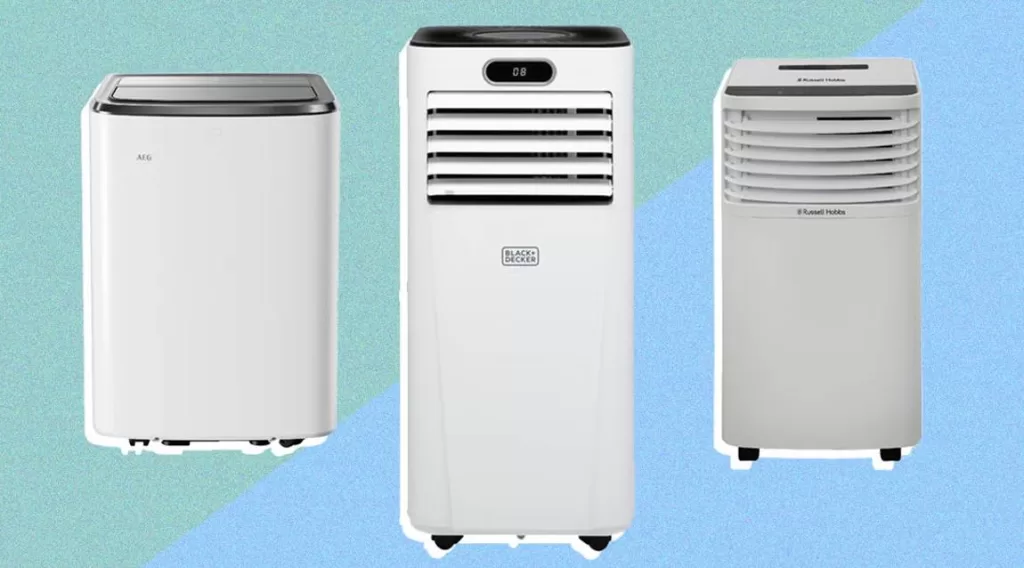
Portable vs. Ductless Mini-Splits
When it comes to finding the best air conditioning solution for your space, you may come across two popular options: portable air conditioners and ductless mini-split systems. While both of these options provide effective cooling, they differ in terms of installation, convenience, and energy efficiency. Let’s take a closer look at the advantages and considerations of both portable and ductless mini-split air conditioners.
Portable Air Conditioners
Portable air conditioners are versatile and easy to install. These units typically come with wheels, allowing you to move them from room to room as needed. They also come with an exhaust hose that you need to vent through a window. This flexibility makes portable air conditioners a popular choice for those who live in apartments or rental properties and cannot make permanent modifications to their space.
However, there are a few things to consider when it comes to portable air conditioners. First, they tend to be less efficient than ductless mini-splits. Portable units consume more energy due to the constant movement and exchange of warm air. Additionally, portable air conditioners can be a bit noisy, especially if you are using them in a bedroom or a quiet workspace.
Ductless Mini-Split ACs
On the other hand, ductless mini-split ACs offer a more permanent and efficient cooling solution. These systems consist of an outdoor compressor unit and one or more indoor units. The indoor units are mounted on walls or ceilings, allowing for zoned cooling and precise temperature control. Ductless mini-splits are known for their silent operation, providing a peaceful and comfortable environment.
Major Advantages
One of the major advantages of ductless mini-split systems is their energy efficiency. Unlike portable units, ductless mini-splits don’t require any ductwork, therefore eliminating the potential energy loss associated with traditional central air conditioning systems. They also utilize inverter compressor technology, which adjusts the speed of the compressor based on the cooling needs, resulting in efficient and precise temperature control.
In terms of installation, ductless mini-split systems do require professional installation. This ensures that the system is properly sized and mounted, maximizing its performance and energy efficiency. The initial cost of a ductless mini-split system may be higher compared to a portable unit, but the long-term energy savings can make up for the investment over time.
Individual Space Requirements
So, when deciding between portable air conditioners and ductless mini-split systems; consider the specific needs of your space.
Portable air conditioners are great for temporary cooling solutions and for spaces where installation is not possible. They offer convenience and mobility but at the expense of energy efficiency.
On the other hand, ductless mini-split systems provide permanent and energy-efficient cooling, making them a popular choice for homeowners and businesses looking for a long-term solution.
Installation Requirements and Professional Help
When it comes to installing a ductless mini-split air conditioner; it’s important to remember that this is not a DIY project. Professional installation is required to ensure that the system is properly sized and mounted, maximizing its performance and energy efficiency.
Unlike portable air conditioners that you can simply plug in and start using, ductless mini-splits involve more complicated installation processes. This is because they consist of both an outdoor compressor unit and one or more indoor units, which need to be strategically placed in your home.
Professional installation begins with a thorough assessment of your space. An experienced technician will determine the appropriate size and number of indoor units needed to cool your home effectively. They will also locate the ideal placement for the outdoor compressor unit, considering factors such as noise levels and accessibility.
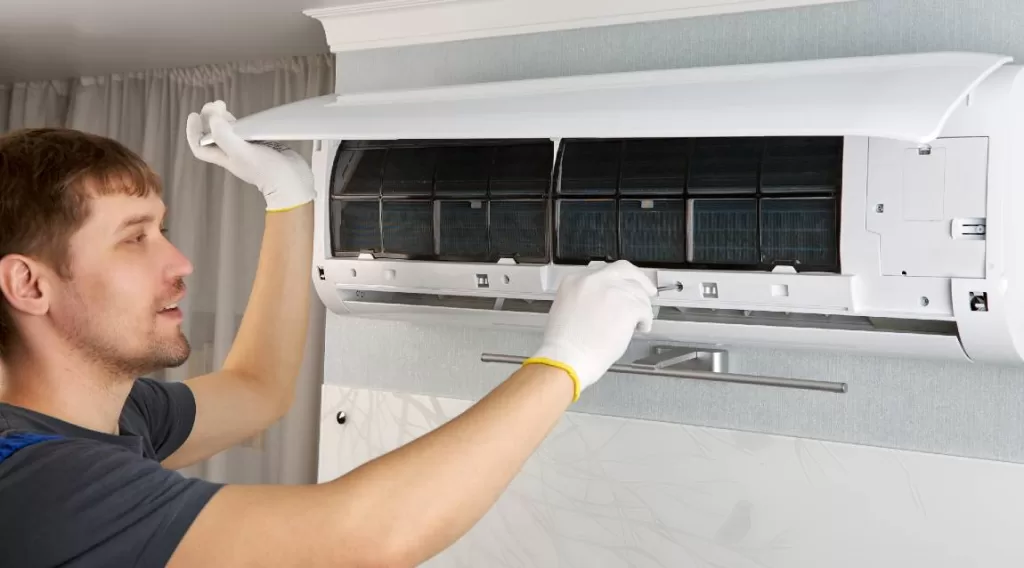
Installing Process
Once the sizing and placement are determined, the installation process begins. This involves mounting the indoor units on walls or ceilings and connecting them to the outdoor compressor unit through refrigerant lines. The technician will also install the necessary electrical wiring and ensure that the system is properly sealed and insulated.
The expertise of a professional installer is crucial in achieving the optimal performance and energy efficiency of your ductless mini-split system. They have the knowledge and experience to handle the complexities involved, ensuring that everything is done correctly and according to manufacturer guidelines.
Cost
While the initial cost of professional installation may seem higher compared to the ease of setting up a portable air conditioner, it’s important to consider the long-term benefits. A properly installed ductless mini-split system can lead to significant energy savings and lower utility bills over time.
Additionally, professional installation guarantee that your system operates at its best, providing you with reliable and efficient cooling for years to come. It also ensures that you are following any warranty requirements, as many manufacturers require professional installation for the warranty to remain valid.
In conclusion, when it comes to installing a ductless mini-split air conditioner, it’s essential to seek professional help. Their expertise will not only ensure a proper installation but also maximize the performance and energy efficiency of your system. So, invest in professional installation and enjoy the comfort and cost savings of a professionally installed ductless mini-split air conditioner.
DIY Installations for Window Units or Portable Systems
When it comes to beating the summer heat, window units and portable air conditioning systems are go-to options for many homeowners. These units offer convenience and affordability, allowing you to cool specific areas of your home without the need for a central cooling system. One of the biggest advantages of these systems is the ease of installation, which can often be done as a DIY project.
Window ACs
For window units, installation typically involves selecting a suitable window, measuring the dimensions, and ensuring a proper fit.
- First, you’ll need to open the window and remove any screens or obstacles that may hinder installation. Then, measure the height and width of the window to determine the right size unit for your space. Make sure to account for any adjustments needed to fit the unit securely.
- Next, place the unit on the windowsill and slide the side curtains or panels into position, securing them in place with screws or brackets provided. Make sure the unit is centered and level, and then lower the window sash onto the top of the unit to hold it in place. Finally, use weatherstripping or foam insulation to seal any gaps around the unit to prevent air leakage.
DIY Portable ACs
Portable air conditioning systems offer even more flexibility as they can be easily moved from room to room. The installation process is simple and requires minimal tools.
- Start by selecting a suitable location near a window or door where you can easily vent the hot air generated by the unit. Make sure to position the unit on a level surface and remove any obstacles around it.
- Next, attach the provided hose or exhaust vent to the back of the portable AC unit. This hose should be routed to the outside through a slightly opened window or door. Secure the hose in place using the window slider kit or other attachments included with the unit. Ensure that the connection is airtight to prevent any hot air from entering the room.
- Lastly, plug in the unit, adjust the settings to your desired temperature, and enjoy the cool, refreshing air. Remember to regularly clean and maintain your window unit or portable system to ensure optimal performance and energy efficiency.
Limitations
While window units and portable air conditioning systems offer easy installation and immediate relief from the heat, they also have some limitations. These units are best suited for cooling small to medium-sized spaces and may not be as energy-efficient as ductless mini-splits or central cooling systems.
Additionally, they may produce more noise and block natural light when installed in windows. Be aware of these factors when deciding on the best cooling solution for your home.
In conclusion, DIY installation for window units and portable air conditioning systems is relatively straightforward and can be accomplished by most homeowners. These cooling options offer convenience, affordability and can be a lifesaver during hot summer months. Just be sure to follow the manufacturer’s instructions, properly seal any gaps or openings, and perform regular maintenance to keep your system running smoothly. Stay cool!
Refrigerant Lines, Outdoor Unit, and Indoor Unit Placement in Ductless Systems
When it comes to ductless mini-split air conditioners, understanding the placement of the refrigerant lines, outdoor unit, and indoor unit is crucial for optimal performance and efficiency. These key components work together to keep your space cool and comfortable while ensuring energy savings.
Refrigerant Lines
Let’s start with the refrigerant lines. These lines are responsible for carrying the refrigerant, a substance that absorbs heat from the indoor air and releases it outside. The refrigerant lines connect the outdoor unit to the indoor unit, allowing for the transfer of heat. It’s essential to properly size and install these lines to ensure efficient cooling and heating.
Outdoor Unit
Regarding the outdoor unit, also known as the outdoor compressor, placement is an important consideration. Ideally, the outdoor unit should be installed in a location that is easily accessible for maintenance and service yet also away from any potential obstructions. It’s best to place the outdoor unit on a concrete pad or sturdy surface, allowing for proper ventilation and drainage.
Indoor Unit Placement
Next, let’s talk about the indoor unit placement. Ductless mini-split systems offer the flexibility of installing multiple indoor units throughout your space. These units, also known as air handlers, are typically mounted on the wall or ceiling and directly distribute cool or warm air into the room. However, it’s essential to consider the layout and size of the room when determining the placement of the indoor units.
Ideally, the indoor units should be positioned in areas where they can effectively distribute air throughout the room. They should also be located away from any obstructions, such as furniture or curtains, that may block the airflow.
Additionally, proper placement of the indoor units can help optimize energy efficiency and ensure even cooling or heating throughout the space.
Summary
In summary, understanding the placement of refrigerant lines, outdoor units, and indoor units is essential when it comes to ductless mini-split air conditioner systems. By ensuring proper installation and placement, you can maximize the performance, energy efficiency, and overall comfort of your cooling and heating system. If you’re unsure about the installation process, it’s always recommended to seek professional assistance to ensure a seamless and effective setup.
Conclusion
When purchasing a mini-split air conditioner, it is important to consider factors such as BTU capacity, energy efficiency, noise level, and additional features, and to consult with a professional for expert advice; take the next step in finding the perfect mini-split air conditioner for your needs by contacting a trusted HVAC specialist today.


